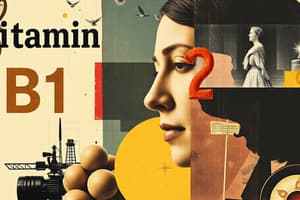Podcast
Questions and Answers
Which two forms of Riboflavin are biologically active?
Which two forms of Riboflavin are biologically active?
Riboflavin deficiency is characterized by which of the following symptoms?
Riboflavin deficiency is characterized by which of the following symptoms?
What is the primary role of FMN and FAD in flavoenzymes?
What is the primary role of FMN and FAD in flavoenzymes?
Which process involves the transfer of an adenosine monophosphate moiety from ATP to FMN?
Which process involves the transfer of an adenosine monophosphate moiety from ATP to FMN?
Signup and view all the answers
Which molecules are formed when FMN and FAD accept two hydrogen atoms?
Which molecules are formed when FMN and FAD accept two hydrogen atoms?
Signup and view all the answers
Study Notes
Riboflavin (Vitamin B2)
- The two biologically active forms of riboflavin are flavin mononucleotide (FMN) and flavin adenine dinucleotide (FAD).
- FMN and FAD are formed by the transfer of an adenosine monophosphate moiety from ATP to FMN.
- Both FMN and FAD can reversibly accept two hydrogen atoms, forming FMNH2 or FADH2.
- FMN and FAD are bound tightly, sometimes covalently, to flavoenzymes.
- Flavoenzymes catalyze the oxidation or reduction of a substrate.
Deficiency Symptoms
- Riboflavin deficiency is not associated with a major human disease.
- Deficiency symptoms include dermatitis, a skin condition characterized by inflammation.
- Cheilosis, a symptom of riboflavin deficiency, is characterized by fissuring at the corners of the mouth.
- Glossitis, another symptom, is characterized by the tongue appearing smooth and purplish.
Studying That Suits You
Use AI to generate personalized quizzes and flashcards to suit your learning preferences.
Description
Learn about the biologically active forms of Riboflavin, its role in oxidation and reduction reactions, and the effects of deficiency.




